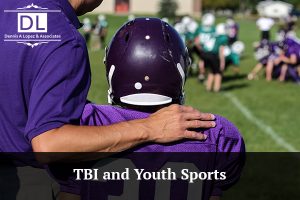 Traumatic brain injuries (TBI) and youth sports are a dangerous combination. The most common type of TBI that affects youth sports is that of the concussion. There’s plenty of research out there that implicates the dangers of concussions in youth sports and how to make contact sports safer for all involved. The most common sport where concussions are prevalent is football, but athletes can suffer concussions even in non-contact sports, such as tennis. Youth players in hockey, soccer, baseball, softball and other sports can easily suffer concussions if they collide with the wall, other players, or the equipment.
Traumatic brain injuries (TBI) and youth sports are a dangerous combination. The most common type of TBI that affects youth sports is that of the concussion. There’s plenty of research out there that implicates the dangers of concussions in youth sports and how to make contact sports safer for all involved. The most common sport where concussions are prevalent is football, but athletes can suffer concussions even in non-contact sports, such as tennis. Youth players in hockey, soccer, baseball, softball and other sports can easily suffer concussions if they collide with the wall, other players, or the equipment.
CTE-Level Damage
CTE-level damage is a serious issue that many youth athletes face each year. CTE, which is short for chronic traumatic encephalopathy, is a term that is heard on the news almost nightly when it comes to stories of former professional football players. This term is widely known among parents of young people who want to play football at the early stages of their childhood and into high school and college.
A study published by a medical journal known simply as Brain has found that repeated blows to the head can lead to CTE-level damage and that concussions aren’t the only cause of CTE-level damage. The brains of four deceased teen athletes were analyzed by the researchers who conducted the study.
The researchers found that traumatic brain injuries caused by sports activities can be caused by closed-head impacts and concussion symptoms don’t need to be present. The overall tone of the study was to show that young athletes who play contact sports are at a higher risk of suffering inflammatory cells and damage to the blood vessels in the brain.
The Alarming Statistics
In 2011 there were more than 55,000 high school football players and more than 29,000 youth soccer players who were diagnosed with a concussion. Because of the known issues with youth concussions in sports, all 50 states and the District of Columbia have enacted laws to address concussions in youth sports and how they are handled. Most of the legislation enacted handles some form of the following:
- A provision for training to recognize the symptoms of concussion and the appropriate responses to those symptoms.
- Taking a youth athlete out of the game or practice if a concussion is suspected.
- Returning the youth athletes to the game or practice after they have been evaluated and then cleared by a health care provider designated by the organization.
The statistics provided from the National Conference of State Legislatures are quite alarming. They are only from 2011. Concussions are serious injuries that should never be overlooked and always cared for properly as immediately as possible.
Tips for Reducing Concussions
Some of the ways youth sports teams can prevent their athletes from suffering concussions include the following:
- Better coaching and training
- Enforcing the existing rules at a stronger clip
- Limiting full-contact practices to reduce repetitive hits on the head
- Providing better equipment
- Strengthening the necks of the players
- Monitoring the head exposure of the players
- Delaying the start of collision and contact sports until a later age
Schedule a Consultation with an Attorney Today
If your youth athlete has suffered a concussion or has been exhibiting signs of a concussion you need to have them medically evaluated immediately. Were the symptoms worsened by your youth athlete being left in the game or practice? Were the proper precautions not met for spotting and evaluating concussions? If so, it’s time to schedule a consultation with an attorney from Dennis A Lopez & Associates. Contact the office in Tampa, Florida today at 813-502-1836.
For More Information
TBI PATIENTS FIND NEW HOPE WITH ADVANCES IN TREATMENT
PERSONAL INJURY IN TAMPA AND THE TRUE COSTS OF A TRAUMATIC BRAIN INJURY
